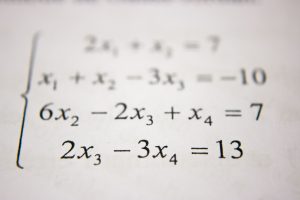
Canadian Robert Langland is probably the greatest mathematician you have never heard of. A recent recipient of the Able Prize, the equivalent to the Nobel Prize in mathematics, Langland’s discoveries of a relationship between number theory and harmonic analysis back in the 1960s has laid the foundation for newer fields of mathematics, such as the classic and expanded versions of the Langland programs (Fairbank, 2018). Langland’s work is extraordinary as it touches on several disciplines within mathematics, a rare occurrence as this requires great talent. But what are the most commonly studied branches of mathematics? Mathematics can be divided into several different fields of study with the three most commonly known ones being arithmetic, algebra, and geometry.
Arithmetic is the best-known and oldest branch of mathematics. It relates to numbers, their relationships, and their use in solving problems (MacDuffee, 2019). This is the branch of mathematics children first learn in school and includes all the basic mathematical computations: addition, subtraction, division, and multiplication. It also includes counting, the measurement of things, raising to powers, and finding the root of numbers (New World Encyclopedia, 2019). The earliest sign of arithmetic concepts among humans can be traced back to Africa’s Ishango Bone, believed to date back twenty thousand years to a lake community on the border of Zaire and Uganda (Williams, 2008). The Ishango Bone not only appears to be the oldest record of prime numbers but also suggests the use of multiplication in ancient times.
Algebra is another well-known branch of mathematics. Algebra deals with abstract symbols and their manipulation in the form of equations (Coolman, 2015). Strikingly different than other branches of mathematics, it stems from the Golden Age of Islam and is credited to the Persian scholar and mathematician Al-Khwarizmi who wrote the book ‘Al-jabr wa’l muqabalah’ – from which the name algebra comes – in Baghdad in 825 A.D. (Corry, 2019). Elementary algebra is taught in secondary schools around the world and focuses mainly on the variables x and y (Pratt, 2017). Algebra has been highly regarded as such an effective tool by other mathematical domains that subbranches have emerged as a result, ranging from algebraic logic to algebraic geometry.
Geometry is also a commonly known branch of mathematics. Although geometry is found mainly in secondary schools around the world, the basic principles are usually embedded into elementary education as well. As you probably know, geometry concerns itself with shapes and the relationships between objects and spaces (Heilbron, 2019). As one of the oldest branches of mathematics, geometry stems back to ancient Greece with its name derived from the Greek words ‘geo’ and ‘metron’, meaning ‘earth measurement’. Whereas many scholars played a role in its creation, no one was more influential than Euclid and his work entitled The Elements, published over 2000 thousand years ago (Palmer, 2015). Impressively, this book is considered to be the world’s most widely used textbook for geometry and mathematics. It brought together and proved various geometric ideas already in use at the time (Palmer 2015).
Although mathematics has a number of different branches of study, the three most commonly known ones are arithmetic, algebra, and geometry. More sophisticated branches include statistics, trigonometry, and calculus – with the latter two also taught in many secondary schools. With time, new discoveries will be made that will lead to new branches of mathematics, just like Langdon’s discoveries have. A hundred years from now who knows how many branches there will be and what mathematics will look like.
References
Coolman, R. (2015). What is algebra? Retrieved February 17, 2020 from https://www.livescience.com/50258-algebra.html
Corry, L. (2019). Algebra mathematics. Retrieved February 17, 2020 from https://www.britannica.com/science/algebra/Classical-algebra
Fairbank, V. (2018). The greatest mathematician you have never heard of. Retrieved February 16, 2020 from https://thewalrus.ca/the-greatest-mathematician-youve-never-heard-of/
Heilbron, J. (2019). Geometry. Retrieved February 17, 2020 from https://www.britannica.com/science/geometry
MacDuffee, C. (2019). Arithmetic. Retrieved February 16, 2020 from https://www.britannica.com/science/arithmetic
New World Encyclopedia (2019). Arithmetic. Retrieved February 16, 2020 from https://www.newworldencyclopedia.org/entry/Arithmetic
Palmer, N. (2015). Euclid. Retrieved February 17, 2020 from https://www.ancient.eu/Euclid/
Pratt, V. (2017). Algebra. Retrieved February 17, 2020 from https://plato.stanford.edu/entries/algebra/
Williams, S. (2008). Mathematicians of the African diaspora. Retrieved February 16, 2020 from http://www.math.buffalo.edu/mad/Ancient-Africa/ishango
Comprehension Questions
Vocabulary Exercises
Academic Writing Exercises
Contextual Grammar Exercises

